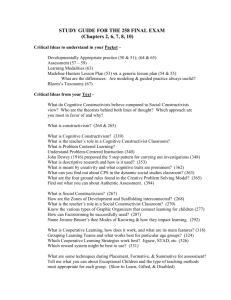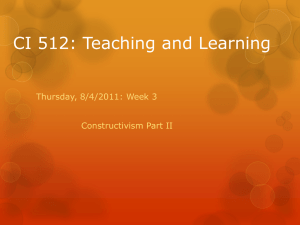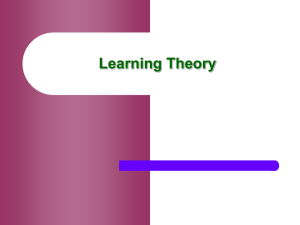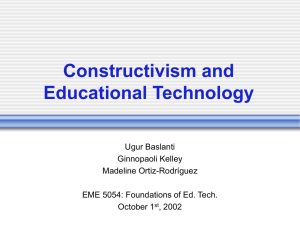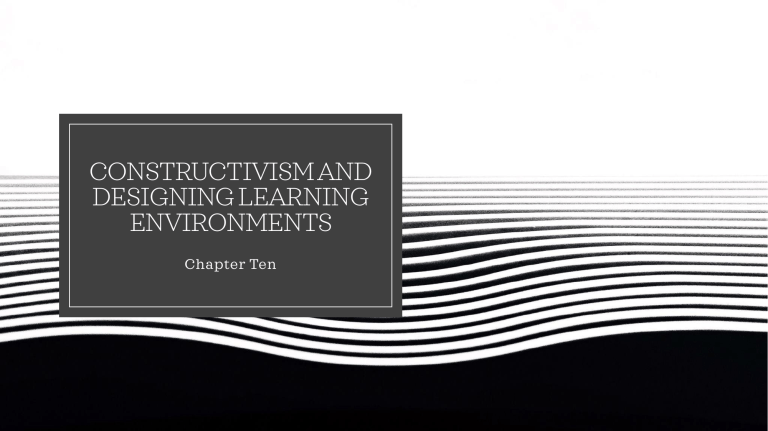
CONSTRUCTIVISM AND DESIGNING LEARNING ENVIRONMENTS Chapter Ten OUTLINE I. COGNITIVE AND SOCIAL CONSTRUCTIVISM II. DESIGNING CONSTRUCTIVIST LEARNING ENVIRONMENTS III. COLLABORATION AND COOPERATION IV. DESIGNING LEARNING ENVIRONMENTS IN A DIGITAL WORLD COGNITIVE AND SOCIAL CONSTRUCTIVISM Constructivist Views of Learning ◦ Psychological Constructivism: Individuals construct their own cognitive structures as they interpret their experiences in particular situations ◦ Focuses on: ◦ How individuals build up elements of their cognitive or emotional apparatus ◦ The inner psychological life of people ◦ The outside world acts as a source of input ◦ First-Wave Constructivism – Piaget ◦ ◦ ◦ ◦ Piaget focuses more on meaning as it is constructed by the individual (not necessarily a correct representation) Thinking becomes more organized as children age Concern with logic : Such knowledge comes from reflection Social environment important factor, but social interaction was not the main mechanism for changing thinking COGNITIVE AND SOCIAL CONSTRUCTIVISM Constructivist Views of Learning ◦ Radical Constructivism: Perspective that holds that individuals can never know objective reality or truth; they can only know what they perceive and believe ◦ Learning is replacing one’s own construction with another that better explains the person’s perception of reality Reflect: ◦ Social Constructivism: Social interaction, cultural tools, and activity shape individual development and learning ◦ Second-Wave Constructivism – Vygotsky ◦ Learning meaning means belonging to a group and participating in the social construction of knowledge ◦ was a mix between psychological/social constructivism ◦ Zone of proximal development: area in which a child can solve a problem with the help of an adult or more able peer ◦ Culture creates cognition – when adults use tools and practices to steer the child ◦ Cognition creates culture – adult and child generate new practices and COGNITIVE AND SOCIAL CONSTRUCTIVISM Constructivist Views of Learning ◦ Constructionism: How public knowledge in disciplines such as science, math, economics, or history is constructed ◦ Social constructivists do not focus on individual learning Focus on public knowledge ◦ Knowledge is socially constructed ◦ Some people have more power ◦ Diverse viewpoints encouraged COGNITIVE AND SOCIAL CONSTRUCTIVISM How Is Knowledge Constructed? ◦ How is Knowledge Constructed? 1. Building mental representations ◦ The realities and truths of the external world direct knowledge construction 2. Gradual development ◦ Internal processes such as Piaget’s organization, assimilation, and accommodation direct knowledge construction ◦ New knowledge is abstracted from old knowledge 3. Through Interactions ◦ Both external and internal factors direct knowledge construction ◦ Internal (cognitive) ◦ External (environmental and social) Vygotsky – Use of cultural tools COGNITIVE AND SOCIAL CONSTRUCTIVISM Knowledge: Situated or General? ◦ General ◦ Knowledge is transferable to other situations ◦ Examples of transferable knowledge? ◦ Situated – Vygotsky ◦ Situated Learning: The idea that skills and knowledge are tied to the situation in which they were learned and that they are difficult to apply in new settings ◦ Some ideas may be useful within a specific area, but useless outside that area COGNITIVE AND SOCIAL CONSTRUCTIVISM Knowledge: Situated or General? ◦ General ◦ Knowledge is transferable to other situations ◦ Community of practice Social situation or context in which ideas are judged useful or true ◦ Over time, the current practice may be questioned and even overthrown, but until such major shifts occur, current practice will shape what is considered valuable, and even what is considered knowledge. ◦ Situated – Vygotsky ◦ Situated Learning: The idea that skills and knowledge are tied to the situation in which they were learned and that they are difficult to apply in new settings ◦ Some ideas may be useful within a specific area, but useless outside that area COGNITIVE AND SOCIAL CONSTRUCTIVISM Common Elements of Constructivist Student-Centered Teaching ◦ Complex Learning Environments and Authentic Tasks ◦ Give problems with many parts ◦ Social Negotiation ◦ Be able to defend their own positions ◦ Respect the positions of others ◦ Multiple Perspectives and Representations of Content ◦ Gain different ways of viewing content ◦ Understanding the Knowledge Construction Process ◦ Make students aware of their own role in constructing knowledge ◦ Student Ownership of Learning ◦ Students’ effort to learn is the main focus DESIGNING CONSTRUCTIVIST LEARNING ENVIRONMENTS Facilitating in a Constructivist Classroom ◦ Elicit students’ ideas and experiences in relation to key topics, then fashion learning situations that help students elaborate on or restructure their current knowledge. ◦ Provide students with a variety of information resources as well as the tools (technological and conceptual) necessary to mediate learning. ◦ Make their own thinking processes explicit to learners and encourage students to do the same through dialogue, writing, drawings, or other representations. ◦ Encourage students’ reflective and autonomous thinking in conjunction with the conditions listed above. ◦ Employ a variety of assessment strategies to understand how students’ ideas are evolving and then give feedback on the processes as well as the products of their thinking. DESIGNING CONSTRUCTIVIST LEARNING ENVIRONMENTS ◦ Scaffolding: Teachers and students make meaningful connections between what the teacher knows and what the students know and need in order to help the students learn more. ◦ Three main characteristics 1. Contingency Support: The teacher is constantly adjusting, differentiating, and tailoring responses to the students. 2. Fading: The teacher gradually withdraws support as the students’ understanding and skills deepen. 3. Transferring Responsibility: Students assume more and more responsibility for their own learning ◦ Inquiry learning: Approach in which the teacher presents a puzzling situation and students solve the problem by gathering data and testing their conclusions. ◦ formulate hypotheses to explain the event or solve the problem, ◦ collect data to test the hypotheses, ◦ draw conclusions, and ◦ reflect on the original problem and the thinking processes needed to solve it. DESIGNING CONSTRUCTIVIST LEARNING ENVIRONMENTS ◦ Problem-based learning: Students are confronted with a problem that launches their inquiry as they collaborate to find solutions and learn valuable information and skills in the process. ◦ Designed to help students develop knowledge that is useful and flexible ◦ Cognitive apprenticeship : A relationship in which a less-experienced learner acquires knowledge and skills under the guidance of an expert. ◦ Students observe an expert model the performance ◦ Students get support through coaching or tutoring ◦ Students receive scaffolding that gradually fades ◦ Students articulate their knowledge ◦ Students reflect on their progress ◦ Students explore new ways to apply what they are learning DESIGNING CONSTRUCTIVIST LEARNING ENVIRONMENTS ◦ Reciprocal teaching : Learning to apply the strategies of questioning, summarizing, predicting, and clarifying; designed to help students understand and think deeply about what they read. ◦ Designed to help students understand and think deeply about what they read ◦ Strategies in Reading: ◦ Summarizing the content of a passage ◦ Asking a question about the central point ◦ Clarifying the difficult parts of the material ◦ Predicting what comes next ◦ Guidelines for effective reciprocal teaching: ◦ Shift gradually – Shift from teacher to student responsibility must be gradual ◦ Match demands to abilities – Difficult tasks and responsibility must match the abilities of each student ◦ Diagnose thinking – Student thinking should be observed COLLABORATION AND COOPERATION ◦ Collaboration : A philosophy about how to relate to others—how to learn and work. ◦ Cooperation : Way of working with others to attain a shared goal. ◦ Cooperative learning: Situations in which elaboration, interpretation, explanation, and argumentation are integral to the activity of the group and where learning is supported by other individuals. ◦ Five elements that define true cooperative learning groups: ◦ Positive interdependence ◦ Promotive interaction ◦ Individual accountability ◦ Collaborative and social skills ◦ Group processing COLLABORATION AND COOPERATION ◦ WHAT CAN GO WRONG: MISUSES OF GROUP LEARNING. ◦ Students often value the process or procedures over the learning. Speed and finishing early take precedence over thoughtfulness and learning. ◦ Socializing and interpersonal relationships may take precedence over learning. ◦ Students may simply shift dependency from the teacher to the “expert” in the group; learning is still passive, and what is learned can be wrong. ◦ Status differences may be increased rather than decreased. Some students learn to “loaf” because the group progresses with or without their contributions. Others become even more convinced that they are unable to understand without the support of the group. COLLABORATION AND COOPERATION Tasks for Cooperative Learning 1. Positive interdependence ◦ Members can attain their goals only if the others in the group do as well 2. Promotive interaction ◦ Members encourage each other’s efforts 3. Individual accountability ◦ Students are responsible for their own learning 4. Collaborative and social skills ◦ Giving constructive feedback, reaching consensus, and including other members 5. Group processing ◦ Members ensure the group is working effectively COLLABORATION AND COOPERATION Tasks for Cooperative Learning Assigning Roles ◦ Possible Roles: ◦ Encourager ◦ Coach ◦ Checker ◦ Recorder ◦ Gate Keeper ◦ Taskmaster ◦ Can assign audience members listening roles ◦ Roles support learning, not ends in themselves COLLABORATION AND COOPERATION Design for Cooperation ◦ Reciprocal Questioning: Students work in pairs or triads to ask and answer questions about lesson material ◦ Jigsaw classroom: A learning process in which each student is part of a group and each group member is given part of the material to be learned by the whole group. Students become “expert” on their piece and then teach it to the others in their group. ◦ Constructive/Structured controversy: Students work in pairs within their four person cooperative groups to research a particular controversy. ◦ ◦ ◦ ◦ ◦ ◦ Each pair researches the issue They develop a pro and con position They present their position and evidence The pairs discuss the issue together The pairs reverse positions Total group forms a final report DESIGNING LEARNING ENVIRONMENTS IN A DIGITAL WORLD Technology and Learning ◦ Virtual learning environments (VLE): A broad term that describes many ways of learning in virtual or online systems. ◦ Learning management system (LMS): Systems that deliver e-learning, provide tools and learning materials, keep records, administer assessments, and manage learning. ◦ Personal learning environment (PLE): Provides tools that support individualized learning in a variety of contexts and situations. ◦ Personal learning network (PLN): Framework in which knowledge is constructed through online peer interactions. ◦ Immersive virtual learning environment (IVLE): A simulation of a real-world environment that immerses students in tasks like those required in a professional practicum. ◦ Massive multi-player online games (MMOG): Interactive gaming environments constructed in virtual worlds where the learner assumes a character role, or avatar. DESIGNING LEARNING ENVIRONMENTS IN A DIGITAL WORLD Developmentally Appropriate Computer Activities for Young Children ◦ Is digital media appropriate for preschool children? ◦ Hotly debated ◦ Potential danger: Visuals or sound effects could interrupt with the development of concepts ◦ Might make children better at multitasking but worse at deeper thought processes ◦ Students have to be media/digital literate Computational thinking & Coding ◦ Computational thinking: The thought processes involved in formulating problems so you can represent their solution steps and algorithms for computing. ◦ computational thinking is a skill that students should begin to develop in elementary school ◦ Media / Digital Literacy: Today-to be able to read, write, and communicate—children have to read and write in many media, not just printed words. DESIGNING LEARNING ENVIRONMENTS IN A DIGITAL WORLD ◦ Flipped classroom—lessons, lectures, note taking, worksheets, direct teaching—is moved outside class, and what usually happens at home—homework, projects, practice—happens in class under the teacher’s supervision and support. ◦ Allows the individual student to learn at his or her own pace away from school, and transforms the classroom into a more dynamic and interactive group learning space where time can be spent reviewing and applying concepts studied at home, getting further teacher or peer explanation and scaffolding, and assessment with feedback. ◦ Invention and creativity should be encouraged. Tambalo, Lester John T. BSBIO4YA-1 EDUCATIONAL PSYCHOLOGY
